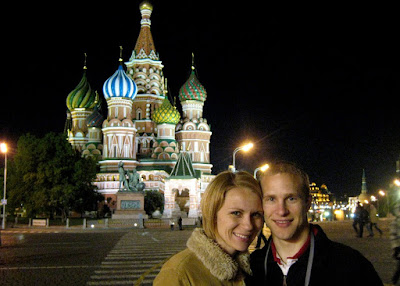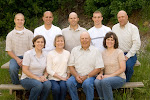I have written about the trip to St. Petersburg while Jeff & Rochelle and Doug & Shannon were visiting us in Moscow, so now I’ll include photos from our visit to Red Square and the Kremlin. Red Square is a “must see” when visiting Moscow.
 The Kremlin and Towers (photo taken March 2007)
The Kremlin and Towers (photo taken March 2007)
The Kremlin has 19 towers in all (plus a 20th tower that is an outlying tower on the bridge). The wall running between them surrounds the Kremlin's buildings.
In the picture above, the Grand Kremlin Palace is visible behind the trees. The Grand Kremlin Palace was once the Moscow palace of the Tsars. The whole complex includes the Terem Palace, several churches, and reception halls. Now it is used for governmental meetings and ceremonies.

The Eternal Flame and close up of the Kremlin Wall

Spasskaya Tower and Kremlin Wall
The Spasskaya Tower of the Kremlin has several interesting details. Built in 1491 by an Italian architect, its gate serves as the Kremlin's "main entrance" from Red Square. The clock on the tower was installed in the middle of the 19th century. The star on top of the Spasskaya Tower is its newest addition, which was added by the Soviets during the 20th century.
 Jeff & Rochelle with Spasskaya Tower behind.
Jeff & Rochelle with Spasskaya Tower behind.

Shannon & Doug - St. Basil's Cathedral
Visitors to Moscow enjoy seeing Red Square at night and having their picture taken with St. Basil’s Cathedral in the background. I never get tired of going there.

Jeff & Rochelle's turn for another “favorite photo op.”

Red Square – National History Museum

GUM Department Store outlined in lights.
We took this picture in February while watching the
Ice skaters on the rink set up during the winter months.
The GUM, Moscow's "State Department Store," takes up almost the entire eastern side of Red Square. It was built between 1890 and 1893 and is the largest store in Moscow. This three-story building features a glass roof, a central fountain inside, and the magical look at night when it’s outlined with white lights.

Russian Orthodox Cathedral in Red Square
 Lenin’s Tomb
Lenin’s Tomb
In February, we bought tickets and went inside.
Lenin is embalmed and lies beneath a glass enclosure.
Those in line file past the tomb without pausing
while guards stand watch.
Lenin's tomb (mausoleum) is next to the Kremlin wall on the east side of the Red Square. At one time, many Russians made the pilgrimage to Moscow and filed by the tomb, but today it is mostly tourists. No cameras are allowed inside, not even in a bag. Between Lenin's tomb and the Kremlin Wall are the graves of over 400 other famous Russian communists, including premiers Breshnev and Andropov, the cosmonaut Yury Gagarin, and the writers Maxim Gorky and John Reed. Stalin is also buried there, although he lay next to Lenin in the mausoleum from 1953 to 1961. Lenin’s Tomb is closed Monday and Friday and only open those days from 10:00 a.m. to 1:00 p.m.
Inside the Kremlin
We bought tickets for a tour of the cathedrals inside the Kremlin, which is the name for a Russian citadel. Sam and I had visited Red Square quite a few times, but we had never gone inside the walls. The Kremlin in Moscow includes four palaces, four cathedrals, and the enclosing Kremlin Wall with Kremlin towers. The complex serves as the official residence of the President of Russia.

The Cathedral of the Annunciation - Kremlin
Originally the royal chapel of the Muscovite tsars, the Annunciation Cathedral's abbot was a personal confessor of the royal family until the early 20th century. Ivan the Terrible had to enter the church by the southeast porch entrance, built especially for him. This is because he was married three times too many (for a total of six wives) and was therefore, under the rules of the Orthodox Church, not allowed to enter the church through its main entrance. The icons of the second and third tiers were painted by some of Russia's greatest masters.

Cathedral of the Assumption (or Cathedral of the Dormition)
In 1547 the coronation of the first Russian Tsar, Ivan the Terrible, took place in the Cathedral of the Assumption; and from 1721, it was the scene of the coronation of the Russian emperors. The ritual installation of metropolitans and patriarchs of the Orthodox Church also took place in this cathedral, and their tombs are found here. After the transfer of the Bolshevik government to Moscow, services in the Kremlin cathedrals were prohibited. In 1990 the Assumption Cathedral was returned to the Church, although a museum still operates within it.

Cathedral of the Archangel
The Cathedral of the Archangel at the Kremlin is packed with the tombs of dead Russian princes. A special area is dedicated to Ivan the Terrible's son, also named Ivan. Ivan famously killed his son during an argument.

The interior of the Cathedral of the Archangel
is entirely covered with Iconostas.

Ivan the Great Bell Tower
Shannon & Doug, Jeff & Rochelle, and Narene
For 600 years, a bell tower has always stood at the site of the Ivan the Great Bell Tower. It was built to be the tallest building in Moscow; and until the 19th century, no buildings in Moscow were permitted to be taller than the Ivan the Great Bell Tower. It is 266 feet high. It was built for the Assumption, Archangel, and Annunciation cathedrals, which do not have their own belfries. It is said to mark Moscow's precise geographic center.

Terem Palace Churches and the Upper Savior's Cathedral
The Terem Palace Churches and the Upper Savior's Cathedral are now a part of the Russian President's residence. Previously, they were used by family members of the tsar - the tsarina (queen) and tsarevna (daughter of the tsar or princess). The cupolas of these churches stand out with their tightly-clustered golden domes and the colorful towers beneath the golden domes.

Shannon - Tsar Bell, Kremlin
When the Tsar Bell was cast in a pit, the metal of the bell was doused with water when workers extinguished a nearby fire. This caused the bell to crack, rendering it useless. It is on display just outside the Ivan the Great Bell Tower.

Doug - Tsar Cannon, Kremlin
The Tsar Cannon, built at the end of the 16th century, is really just for decoration to impress. The contemporary cannon balls are actually too big to fit into the gun of the cannon. The last couple of decades have seen several photos of American and Russian presidents shaking hands in front of the Tsar Cannon.

Government Buildings – Senate (left)
The Senate Building (at the left in the photo above) used to house the government during the last century, but it is now the Russian President's residence. The interior has been updated accordingly, but the exterior still retains its original facade.

Kremlin – Arsenal
The Arsenal at the Kremlin is designed as a storehouse for weapons of all types. Visitors are not allowed inside, but over 750 cannons line the walkway around the building. Today, the arsenal building is primarily used as the command center for the Kremlin guards.
Flowers and trees inside the Kremlin

 Rachel, a BYU intern for the summer and a
Rachel, a BYU intern for the summer and a 





































































